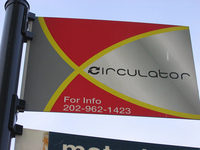DDOT: NextBus not the answer for Circulator
DDOT doesn’t currently plan to integrate the Circulator into the NextBus system. Instead, they plan to develop a separate application for mobile devices to tell you how far away the Circulator is.
DDOT agreed to release an email summarizing their reasons:
Many of the other regional systems disagree with Metro’s approach to bus real-time information. NextBus is proprietary, expensive, rather inflexible, and difficult to administer. … What we’re trying to do with Circulator is use technology we already have (GPS tracking on all Circulator buses) and develop an extremely low-cost application to let people know how far away the next bus is. From a passenger standpoint, this can be just as useful as saying the bus is 5 minutes away.
We’d also have to deal with the fact that the system structure is different. Metrobus runs on a fixed schedule and the NextBus predictions use the fixed schedule to come up with a predicted arrival time. Circulator does not have a fixed schedule and is constantly monitored by the contractor to get the buses arriving as close to a 10-minute interval as conditions allow. The NextBus algorithm is not flexible enough to deal with how the Circulator service is tailored in real time.
Last I would argue that a NextBus type system is less important for an operation like the Circulator - its entire mission is to run frequently enough so that people don’t have to check to see when it is coming. They should be able to just wait at a stop and know they won’t have to wait any longer than 10 minutes. For some of the routes/systems that run at 20, 30, or 45 minute headways the actual arrival time is of much greater use to a customer.
The last paragraph, of course, assumes that the bus really does run that frequently. This weekend, that wasn’t the case. Even so, when a UK system added real-time information, people thought the buses arrived more often and more reliably, even when they didn’t.
The rest of the reasons in the DDOT statement ring true, however. A lot of tasks in technology are easy, but integrating different systems with different design parameters is often not one of them. I can certainly believe that NextBus has many specific design constraints, as any system would, and that the WMATA-NextBus contract is narrowly written to meet Metrobus’s needs alone.
We should be able to see for ourselves. WMATA is a public agency, and supported by our tax dollars. We should be able to see the costs and the requirements of the NextBus contract. If the parameters of the deal could better facilitate including non-WMATA, more dynamic services like the Circulator, we should be able to suggest that for the next iteration.
The more important solution is open standards. If the NextBus system doesn’t meet the Circulator’s needs, let some other innovator build a better application. DDOT and Metro should both create data feeds where any developer can download the real-time bus arrival information. Let Google Transit integrate it into their trip planner. Let someone else build an even better application that not only tells you when your bus will come, but suggests alternate routes, and recommends a coffee shop along the way.
For now, something separate is better than nothing. A low-cost application is a good start. Ideally, we’d install real-time digital displays at the stops. In the meantime, DDOT already posts the phone number on the signs, and that number should tell callers how far away the next bus is. In the long run, both Metro and the other regional agencies should open up the real-time feeds, so future developers, whether at NextBus, Google, or in someone’s garage, can build the integrated real-time system we really deserve.

